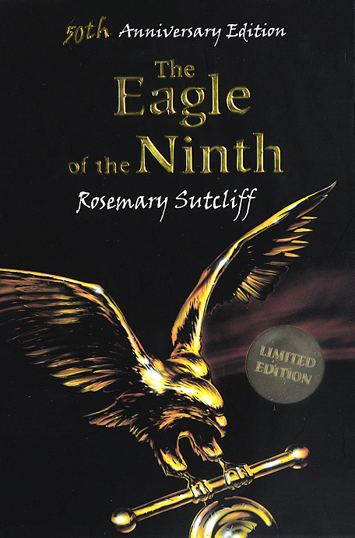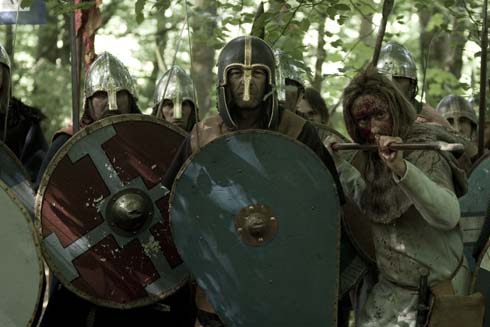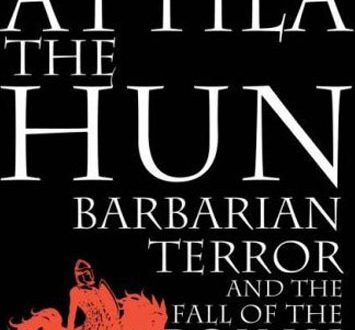The Eagle of the Ninth has been called a modern classic of children’s fiction. Originally published in 1954, interest has been rekindled in it by a new film of the story being shot. The movie will be directed by Kevin Macdonald (The Last King of Scotland), and star Channing Tatum (G.I Joe: Rise of the Cobra) and Jamie Bell (Billy Elliot). The big names guarantee maximum publicity for the film and, as a result, renewed interest in the book.
In the foreword of the book, Sutcliff cites inspiration for the plot from two stories linked to Roman Britain: the disappearance of the Ninth Legion after it marched north from York in 117AD and the discovery of ‘a wingless Roman Eagle’ excavated at Silchester.
I grew up in York overlooking the road that (I was told) was the one the Legion had last been seen marching along. The story of Harry Martindale in the cellars of the Treasurers House watching phantoms of the soldiers marching to their doom was another example of a legend created by the mystery. I was intrigued to see what tale Sutcliff would weave.
The plot of the book certainly does not disappoint. The main protagonist is Marcus Aquila, who grew up in Clusium, Italy while his father and uncle soldiered in Britain. His father had commanded the First Cohort of the Hispana (Ninth Legion) “which meant having charge of the Eagle and being something very like second-in-command of the Legion beside” when they marched northwards. Orphaned at the age of 10, Marcus’ ultimate aim is to restore the honour of his father’s legion.
Finding Inspiration from Roman Britain
As the book begins, Marcus is marching towards Isca Dumnoniorum (Exeter) to be the cohort commander of the garrison. A few months later, the Romans are attacked. In the battle, Marcus is injured. His smashed thigh bone and the torn muscles in his right thigh halt any possible career in the Roman Army. He goes to his uncle’s house in Calleva (a now-abandoned Roman town between Basingstoke and Reading) to recuperate. This means that Sutcliff is able to describe both military and civilian life in Roman Britain, something she does brilliantly. (“Through the doorless opening Marcus could see almost the whole of the sleeping cell, the narrow cot piled with gay native rugs, the polished oaken chest, the lamp-bracket high on the bare wall, and nothing more. The outer room held the battered writing-table on which Marcus was sitting, a cross-legged camp-stool, the cushioned bench to represent comfort, another chest for the record rolls, and a bronze pedestal lamp of peculiarly hideous design.”)
While staying at his uncle’s house, Marcus visits the Saturnalia Games which boast fighting between wolves and bears, and also features slaves as gladiators. After sensing the fear of one slave, he is able to turn the opinion of the arena and ask for mercy when this slave is defeated. The next day, Marcus buys the slave, Esca, and they become friends. During this period, Marcus also develops strong relationships with a wolf cub taken from its lair and Cottia, his uncle’s 13-year-old neighbour.
Faultlines Emerge
The main fault with the book is that as interesting as all these relationships and details are, they are secondary to the main plot of the story. And this does not properly start until page 122 when Marcus hears rumours that the Ninth Legion’s eagle is being worshipped by a tribe beyond Hadrian’s Wall. He and Esca go on a quest to recover the eagle and restore the honour of the Legion and Marcus’ father. It will be interesting to see to what extent the first part of the book is ignored or sidelined in the film version of the story.
Another problem with the book is that its historical basis is now being questioned. As you can see, it is now more likely that the Ninth Legion was disbanded rather than mysteriously disappearing. Likewise, the bird found at Silchester is now known not to have been a legionary eagle.
One episode of the quest into Scotland that really stands out is the pagan Feast of New Spears. (“From all over the tribe, the boys come, and their fathers with them. If it were the King’s son, still he must come to us, when it is time for him to receive his weapons.”) I believe this section enabled Sutcliff to use her imagination more and the writing really improves with the freedom.
While The Eagle of the Ninth is an excellent basis for a film, there is little here that inspires me to read the other two books in the trilogy (The Silver Branch and The Lantern Bearers). It is too slow moving to satisfy most young readers, but could maybe be considered for reading aloud (a chapter at a time) to classes studying Roman Britain thanks to its marvellous detail.


 by Rosemary Sutcliff
by Rosemary Sutcliff



